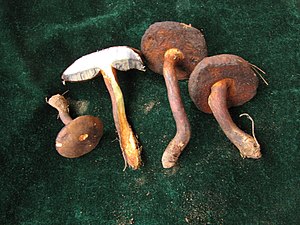Neoboletus brunneissimus
| Neoboletus brunneissimus | ||||||||||||
|---|---|---|---|---|---|---|---|---|---|---|---|---|

Neoboletus brunneissimus in a market in Yunnan |
||||||||||||
| Systematics | ||||||||||||
|
||||||||||||
| Scientific name | ||||||||||||
| Neoboletus brunneissimus | ||||||||||||
| ( WF Chiu ) Gelardi , Vizzini & Simonini |
Neoboletus brunneissimus is a species of fungus from the family of Dickröhrlingsverwandten (Boletaceae).
features
Macroscopic features
The hat is hemispherical to domed, with a dry felt surface and reaches a diameter between 2 and 8 centimeters. It has a brownish yellow, yellowish brown, light brown to brown color, but turns light to dark blue when injured. The hymenophore , i.e. the tubular part of the hat, has grown (adnat) to a tooth running down (sinuat). It is also yellowish brown to brown. The tubes are small, 1.5 to 2 millimeters in diameter and 4 to 18 millimeters long, butter yellow to corn yellow when young, olive colored when ripe. The handle is between 4 and 9 centimeters long and 5 to 13 millimeters thick and has a walnut to slightly club-shaped shape. It is brownish yellow with a yellow background to brown in the upper part and brown to earth brown in the lower part, densely covered with speckled scales. At the base there is the cream-colored, brown or yellowish-brown mycelium . The flesh is light yellow to yellow with a brownish yellow to brown base. If injured, it turns a strong blue. Macrochemical reactions are not observed.
Microscopic features
The basidia are 25–40 × 9–11.5 micrometers in size, club-like, translucent , with KOH sometimes with yellow pigments and four-pore. The spores have a spindle-shaped, unequal-sided shape, are 10-14 × 4.5-5 micrometers in size, yellowish brown, smooth and do not stain with iodine inamyloid . The cheilocystids are bulbous-spindle-shaped to bulbous-prickly and usually contain yellow to brownish-yellow pigments. They grow to be 20–43 × 4–9 micrometers in size. The pleurocystids are 27–49 × 6–10 micrometers in size, are similar in shape to the cheilocystids, have thin walls and rarely have pigments. The top layer of the hat is a trichoderm with brown to yellowish brown hyphae . There are no buckles .
Species delimitation
The flaky-stemmed witch's boletus ( Neoboletus luridiformis ) is similar, but has red pores and red speckled scales on the stem. In addition, it enters into a mycorrhiza with trees of the temperate zone such as spruce , beech and oak .
Ecology and phenology
Neoboletus brunneissimus grows gregariously or individually in subtropical forests of different pines ( Pinus yunnanensis , Pinus armandii etc.), or beech plants such as pseudo-chestnuts or in mixed forests.
distribution
Neoboletus brunneissimus is only known from southwestern China.
Systematics
Neoboletus brunneissimus was first described as Boletus brunneissimus by the Chinese mycologist Wei Fan Chiu in 1948 . Matteo Gelardi , Alfredo Vizzini and Giampaolo Simonini placed the species in the newly described genus Neoboletus in 2014 .
swell
Individual evidence
- ↑ a b c d e f Gang Wu, Kuan Zhao, Yan-Chun Li, Nian-Kai Zeng, Bang Feng, Roy E. Halling, Zhu L. Yang: Four new genera of the fungal family Boletaceae . In: Fungal Diversity . tape 81 , no. 1 , November 2016, p. 1-24 , doi : 10.1007 / s13225-015-0322-0 ( researchgate.net ).
- ↑ MycoBank: neoboletus brunneissimus . Retrieved November 6, 2017 .
- ^ Alfredo Vizzini: Index Fungorum no.192. October 17, 2014, accessed on January 21, 2015 .